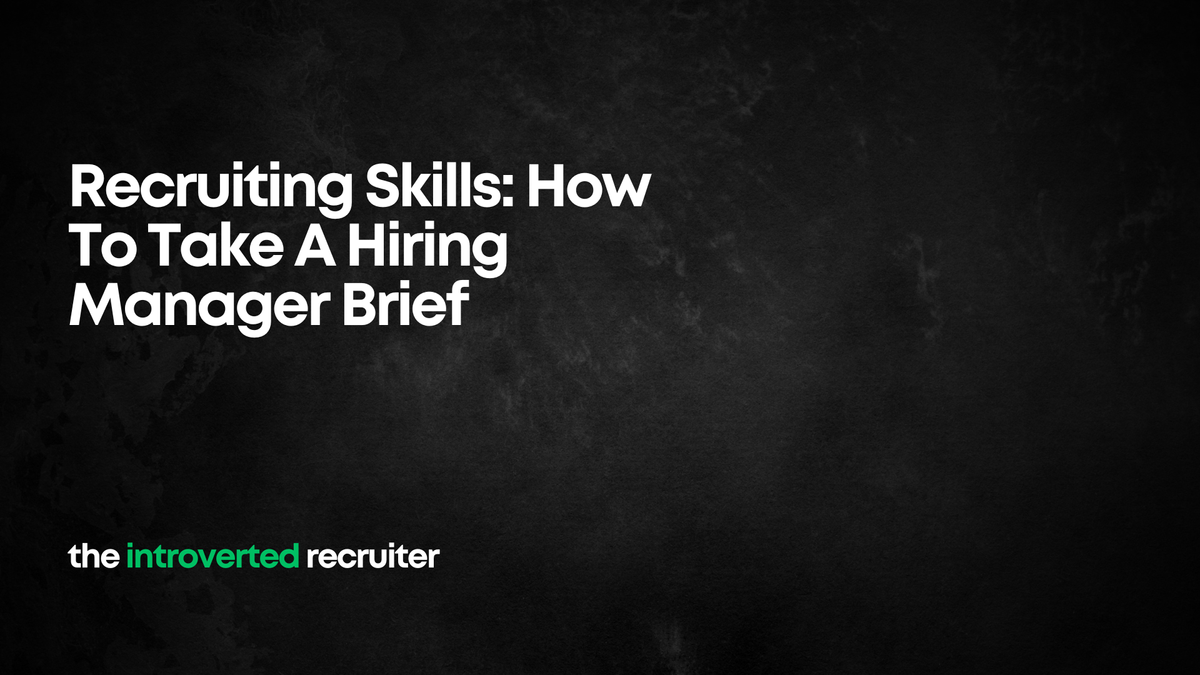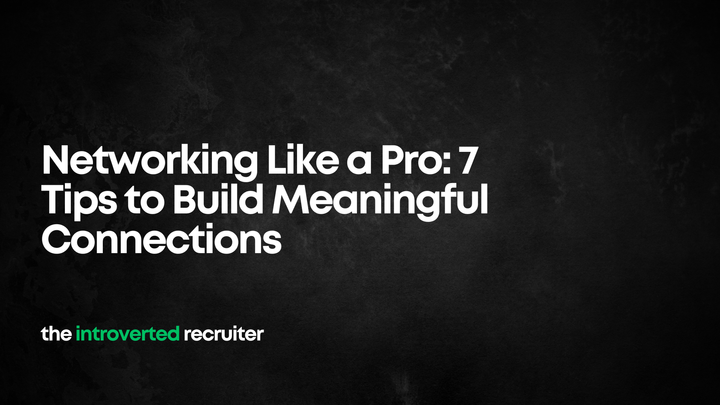Recruiting Skills: How To Take A Hiring Manager Brief

The moment you sit down with a hiring manager to take a brief is the single most important part of the recruitment process.
If you don’t get this right you will waste a huge amount of time and energy, struggle to fill the vacancy, give a terrible candidate experience, horrendous hiring manager experience and you as a recruiter won’t have a great time either.
Before the brief
Do some research. You want to be going to the briefing session with a few things you’ve already prepared.
Market Insight
Chances are that you already have the Job Description or at least have some understanding of the role you’re going to be discussing with the manager, time to get some market insight so you can get an understanding of the talent landscape:
What is the size of the talent market based on your current understanding of the role? How does that vary if the requirements change? By way of example, if you’re looking for a .NET Developer without AWS experience the talent pool is 300% bigger than those with AWS.
How essential is AWS to the hiring manager’s requirements? Is it something that can be taught or learned on the job?
What is the average salary for this type of role in the market? Do you underpay, overpay or are you median payers? How do you stack up? In the above example, what impact does a requirement such have AWS have on candidate salary expectations?
Who else is recruiting for this role right now? How does our offering stack up against theirs? Think not just in terms of pay and perks, but how do you stack up in terms of the work and projects? Is your story, your reasons for somebody wanting to join your business as strong as theirs.
Coming armed to the briefing session with this type of insight is key for a few reasons:
- It helps set expectations with your hiring manager as to how easy or difficult a hire this role will be. Setting these expectations upfront is exactly that, it’s setting expectations. Doing this a couple of weeks after the brief can easily be seen as making excuses.
- It can help you redefine the brief. Remember that AWS example earlier, rather then banging your head against the wall looking for a skillset that you either can’t attract or can’t afford, this type of insight can set you up for success from the beginning. If you can’t redefine the brief, at least you’ve set the expectation as to the level of difficulty involved.
- It immediately positions you as a talent expert, gives you credibility and earns trust from a hiring manager – they know they’re in good hands.
The good news is that this type of research doesn’t actually take too long. AI tools, LinkedIn Recruiter, Horsefly, Glassdoor, even job boards can give you a lot of this information.
Historical Hiring Data
Jump into your ATS. The last time this type of role was recruited, what do the numbers look like? What was your time to offer? What did the funnel look like, how many candidates did you need to apply, headhunt, screen and interview to make an offer?
This again helps set expectations but can also be used to help drive change. If the data shows that the hiring manager had to interview 8 candidates to make a single offer, ask why? Was it because the assessment wasn’t fit for purpose? Was it because the manager wasn’t clear on what they were looking for? Was it because we couldn’t sell the role? Could we not meet salary expectations? Does the manager need some interview coaching?
Questions
Think about the type of questions you’re going to be asking during the brief, tie that in with the insight you already have, some examples below to get started:
- Tell me about the last time you recruited this role? What went well? What could have gone better? Why?
- Why is that particular skill or experience so important? How does it relate to their deliverables?
- Probe around buzz words such as “Good communication skills”, “stakeholder management”, “strategic”, “commercial focussed”, “agile” – what do they mean in the context of this role, and why do they matter?
- How are we going to assess against these skills and behaviours? Is the process and format fit for purpose?
- Why would somebody want to leave their current role and come to work for you? What’s in it for them?
- Who do you know? Who does your team know? Who would be great in this role that we can reach out to?
Prep the Manager
If you’re going to be doing all of this prep before a briefing session, shouldn’t the manager be doing some too?
Send them a loose agenda beforehand, give them a heads up of the types of questions you’ll be asking them. This gives them time to put some real thought into it and prepare for the session, rather than them having to think on the spot – especially when asking them to think about who they know or what the compelling story is as to why somebody should join their team.
During the brief
You’ll need at least hour, unless of course you recruit this same role for the same manager quite often.
You have a lot of questions already prepared, you have your insight, your manager should already be prepared. A lot of the hard work has already been done.
During the brief, be curious and don’t be afraid to challenge – if what the manager is looking for doesn’t exist or isn’t affordable, then you have the data and insight to speak up.
If you don’t understand the role, a skill set or literally anything the hiring manager says, make sure you ask! There’s little point in not speaking up when you don’t understand. You won’t be thought less of, your expertise is in acquiring talent, not the intricate details of developing software or managing the P&L.
Once you and the manager have agreed what good looks like and how you’re going to assess that, you next need to agree how you’re going to work together, this is quite often called ‘contracting with your manager’.
Some ideas:
- Let’s grab 15 minutes once or twice week to update each other
- You’ll update each other once per week by email or IM, even if it’s just a “I’ve done x, expect to have some movement by next week”
- The data tells us this is a really in demand skillset so we need to move quickly, lets make sure that all CVs are reviewed within 24 hours. We’ll also need a commitment that you can clear your diary for interviews. If we can’t commit to this now then it’s going to negatively impact our ability to hire.
- As your recruiter, I’ll do some headhunting and manage inbound applications. As the manager can you search and share with your networks, ask your teams to do the same. Can you pull together some content we can share, here’s some examples of what might work.
After the brief
You and the hiring manager now both know what good looks like and have agreed how you’re going to work together. Send a summary by email to your hiring manager with what was agreed, along with your insight.
This is useful for a couple of reasons, firstly it’s a clarification of your understanding of the session to make sure there were no misunderstandings, but it’s also a useful point of reference should something change further down the process.
It’s also worth asking yourself the question – ‘who else needs to know?’. Is it a high profile or urgent role? If so, sending this summary email to the hiring manager’s manager, functional head or even the HR BP area an FYI can also be a good idea. It keeps them informed and gives them the confidence that both you and the hiring manager have a plan and are on it.
Summary
As I’ve said at the top of this article, the brief is the single most important part of any recruitment process.
I’ve seen too many recruiters and hiring managers over the years I’ve been doing this not getting it right, a typical briefing session would be 20 minutes long and largely consist of a hiring manager reading a list of requirements to their recruiter who didn’t have the insight to hand to properly add value to the conversation, set expectations or challenge thinking where needed.
Do it right, you’ll add way more value, set yourself up for success from the offset and the process will be much more enjoyable for all involved – your hiring managers, your candidates and you!
Newsletter
Sign up for my free newsletter on SubStack for all the latest content straight into your inbox.
Follow Me
Find me on LinkedIn , TikTok , YouTube or Instagram where I share lot’s of practical no nonsense advice.



